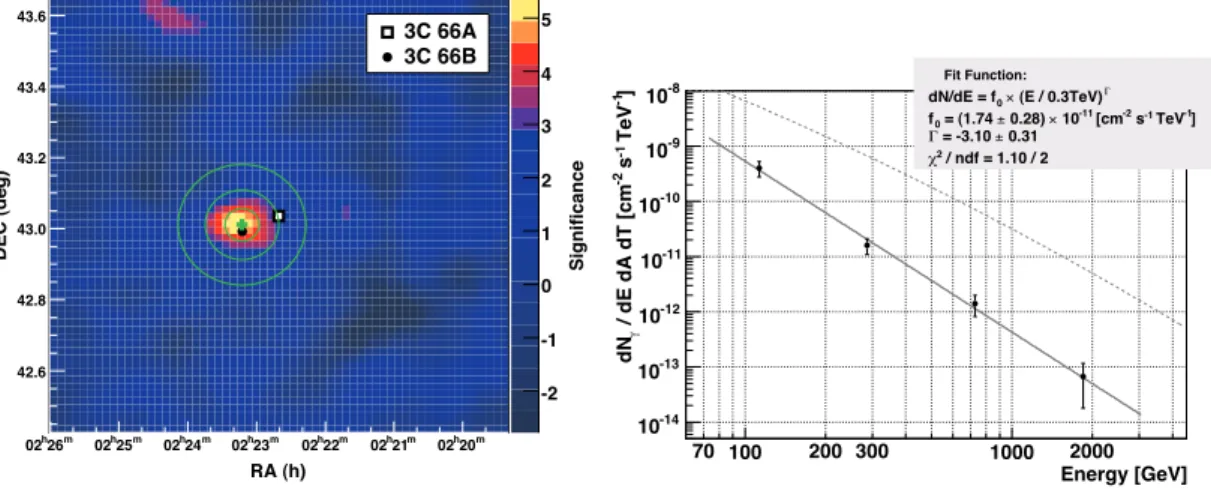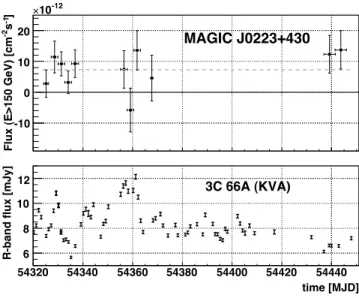DISCOVERY OF A VERY HIGH ENERGY GAMMA-RAY SIGNAL FROM THE 3C 66A/B REGION
D. MAZIN 1 ,
M. Errando 1 , E. Lindfors 2 , E. Prandini 3 , F. Tavecchio 4 for the MAGIC collaboration 5
1 IFAE, Edifici Cn., Campus UAB, E-08193 Bellaterra, Spain, 2 Tuorla Observatory, Turku University, FI-21500 Piikki¨ o, Finland, 3 Universit` a di Padova and INFN, I-35131 Padova, Italy, 4 INAF National
Institute for Astrophysics, I-00136 Rome, Italy, 5 wwwmagic.mppmu.mpg.de/
The MAGIC telescope observed the region around the distant blazar 3C 66A for 54.2 hr in 2007 August–December. The observations resulted in the discovery of a γ-ray source centered at celestial coordinates R.A. = 2 h 23 m 12 s and decl.= 43 ◦ 0. " 7 (MAGIC J0223+430), coinciding with the nearby radio galaxy 3C 66B. A possible association of the excess with the blazar 3C 66A is discussed. The energy spectrum of MAGIC J0223+430 extends up to ∼ 2 TeV and follows a power law with a photon index Γ = − 3.10 ± 0.31 stat ± 0.2 syst .
1 Introduction
As of today, there are 26 known extragalactic very high energy (VHE, defined here as E >
100 GeV) γ -ray sources. All of them are active galactic nuclei (AGNs) with relativistic jets.
With the exception of the radio galaxy M 87 and Cen A all detected sources are blazars, whose jets (characterized by a bulk Lorentz factor Γ ∼ 20) point, within a small angle (θ ∼ 1/Γ), to the observer. The spectral energy distribution (SED, logarithm of the observed energy density versus logarithm of the photon energy) of AGNs shows typically a two-bump structure. For the origin of the high-frequency bump, various models have been proposed, the most popular invoking inverse Compton scattering of ambient photons. There have been several suggestions for the origin of the low-frequency seed photons that are up-scattered to γ-ray energies: they may be produced within the jet by synchrotron radiation (synchrotron self-Compton or SSC mechanism 1 ) or come from outside the jet (external Compton or EC mechanism 2 ). Relativistic effects boost the observed emission as the Doppler factor depends on the angle to the line of sight. In case the jet angle to the line of sight is large, models that depend less critically on beaming effects are needed 3 . The VHE γ-ray emission of AGNs might also be of hadronic origin through the emission from secondary electrons 4 .
3C 66A and 3C 66B are two AGNs separated by just 6 ! in the sky. 3C 66B is a large
Fanaroff–Riley-I-type (FRI) radio galaxy, similar to M 87, with a redshift of 0.0215, whereas
3C 66A is a blazar with uncertain redshift. The often referred redshift of 0.444 5 for 3C 66A
is based on a single measurement of one emission line only, while in later observations no lines
in the spectra of 3C 66A were reported 6 . Based on the marginally resolved host galaxy, a
photometric redshift of ∼ 0.321 was inferred. In this paper we report the discovery of VHE
γ-ray emission located 6. ! 1 away from the blazar 3C 66A and coinciding with the radio galaxy
3C 66B in 2007. Detailed results and discussion can be found in 7 .
DEC (deg)
42.6 42.8 43.0 43.2 43.4 43.6
Sign ifi can ce
-2 -1 0 1 2 3 4 5
RA (h)
20m 02h 21m 02h 22m 02h 23m 02h 24m 02h 25m 02h 26m 02h
3C 66A 3C 66B
Energy [GeV]
70 100 200 300 1000 2000
]
-1TeV
-1s
-2/ dE dA dT [cm
γdN
10
-1410
-1310
-1210
-1110
-1010
-910
-8Fit Function:
(E / 0.3TeV)Γ 0× dN/dE = f
-1] TeV s-1 [cm-2 10-11 0.28) × = (1.74 ± f0
0.31 = -3.10 ± Γ
/ ndf = 1.10 / 2 χ2

